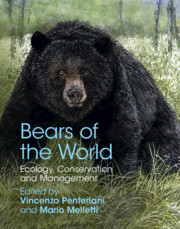Book contents
- Bears of the World
- Bears of the World
- Copyright page
- Dedication
- Frontispiece
- Contents
- Contributors
- Foreword
- Acknowledgments
- Introduction
- Part I Systematics, Ecology, and Behavior
- Part II Species Accounts
- Part III Human–Bear Coexistence
- Chapter 15 Human–Bear Conflicts at the Beginning of the Twenty-First Century: Patterns, Determinants, and Mitigation Measures
- Chapter 16 Principles of Human–Bear Conflict Management in Challenging Environments
- Chapter 17 Patterns of Bear Attacks on Humans, Factors Triggering Risky Scenarios, and How to Reduce Them
- Chapter 18 Effects of Human Disturbance on Brown Bear Behavior
- Chapter 19 Bears in Human-Modified Landscapes: The Case Studies of the Cantabrian, Apennine, and Pindos Mountains
- Part IV Conservation and ManagementConservation and Management
- Index
- Miscellaneous Endmatter
- Plate Section (PDF Only)
- References
Chapter 15 - Human–Bear Conflicts at the Beginning of the Twenty-First Century: Patterns, Determinants, and Mitigation Measures
from Part III - Human–Bear Coexistence
Published online by Cambridge University Press: 16 November 2020
- Bears of the World
- Bears of the World
- Copyright page
- Dedication
- Frontispiece
- Contents
- Contributors
- Foreword
- Acknowledgments
- Introduction
- Part I Systematics, Ecology, and Behavior
- Part II Species Accounts
- Part III Human–Bear Coexistence
- Chapter 15 Human–Bear Conflicts at the Beginning of the Twenty-First Century: Patterns, Determinants, and Mitigation Measures
- Chapter 16 Principles of Human–Bear Conflict Management in Challenging Environments
- Chapter 17 Patterns of Bear Attacks on Humans, Factors Triggering Risky Scenarios, and How to Reduce Them
- Chapter 18 Effects of Human Disturbance on Brown Bear Behavior
- Chapter 19 Bears in Human-Modified Landscapes: The Case Studies of the Cantabrian, Apennine, and Pindos Mountains
- Part IV Conservation and ManagementConservation and Management
- Index
- Miscellaneous Endmatter
- Plate Section (PDF Only)
- References
Summary
Conflicts between humans and bears have occurred since prehistory. Through time, the catalogue of human–bear conflicts (HBC) has been changing depending on the values and needs of human societies and their interactions with bears. Even today, conflict situations vary among the eight species of bears and geographically across these species’ ranges. This results in a broad range of interactions between bears and humans that may be considered as conflicts, including: (1) predation of domestic or semiwild animals, including bees, hunting dogs, and pet animals; (2) damage due to foraging on cultivated berries, fruits, agricultural products, and the tree bark in forest plantations; (3) economic loss due to destruction of beehives, fences, silos, houses, and other human property; (4) bear attacks on humans causing mild or fatal trauma; (5) bluff charges, bear intrusions into residential areas; and (6) vehicle collisions with bears and traffic accidents. In this chapter we aim to outline the principal types of HBC and geographical differences in the occurrence of conflicts and the coexistence between people and bears.
- Type
- Chapter
- Information
- Bears of the WorldEcology, Conservation and Management, pp. 213 - 226Publisher: Cambridge University PressPrint publication year: 2020
References
- 9
- Cited by

